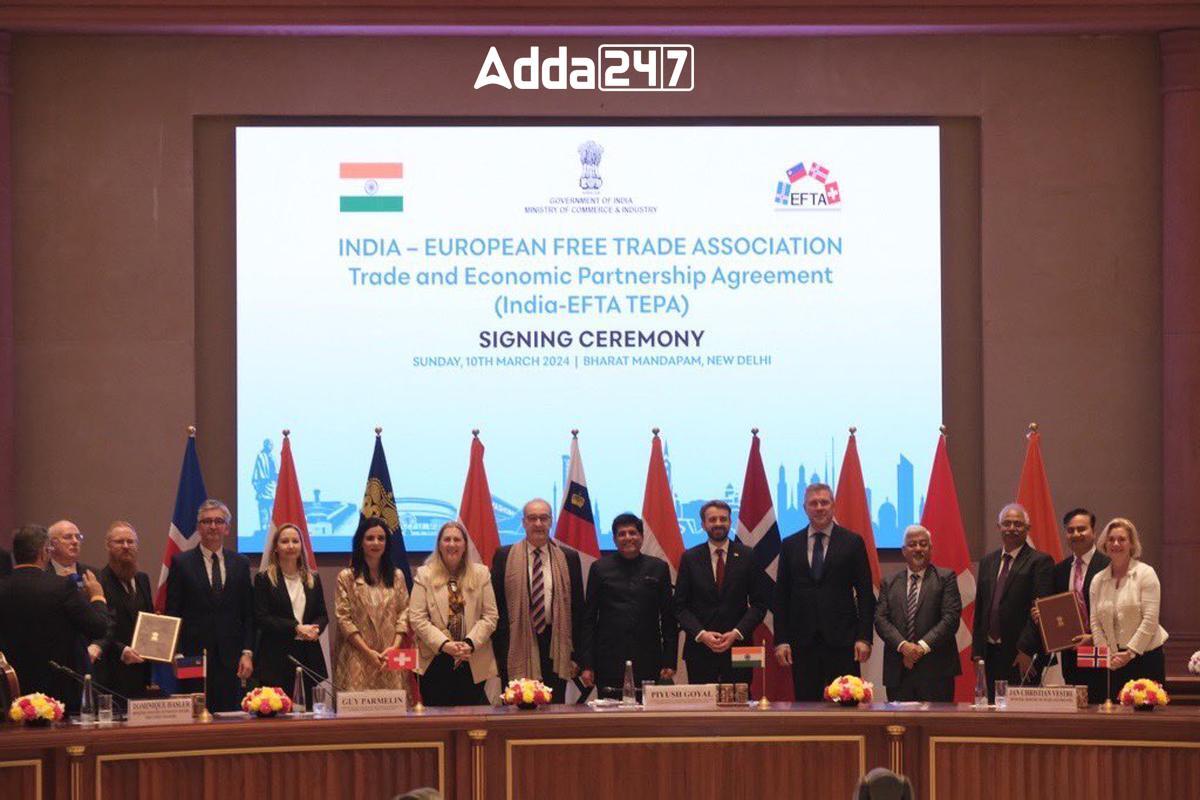India and the European Free Trade Association (EFTA) comprising Switzerland, Iceland, Norway, and Liechtenstein have signed a Trade and Economic Partnership Agreement (TEPA). This modern and ambitious agreement marks India’s first Free Trade Agreement (FTA) with four developed nations in Europe, offering significant economic opportunities and promoting free trade and economic integration.
1. Investment Commitment and Job Creation
- EFTA commits to increasing foreign direct investments in India by $100 billion over the next 15 years, aiming to generate 1 million direct jobs.
- This historic commitment underscores a binding agreement to promote target-oriented investment and job creation, a first in FTAs.
2. Market Access and Tariffs
- EFTA offers access to 92.2% of its tariff lines covering 99.6% of India’s exports, including non-agricultural products and tariff concessions on Processed Agricultural Products (PAP).
- India reciprocates by offering access to 82.7% of its tariff lines covering 95.3% of EFTA exports, with certain sensitive sectors excluded.
3. Sectoral Commitments
- India offers access to 105 sub-sectors for EFTA and secures commitments in various sectors, including 128 from Switzerland, 114 from Norway, 107 from Liechtenstein, and 110 from Iceland.
- Sensitivity to sectors like pharmaceuticals, medical devices, and processed food is addressed, with certain sectors excluded from offers.
4. Services and Intellectual Property Rights (IPR)
- TEPA stimulates services exports, particularly in IT services, business services, education, and audio-visual services.
- Commitments on Intellectual Property Rights are at TRIPS level, addressing concerns related to generic medicines and patent evergreening.
5. Sustainable Development and Market Integration
- TEPA signals commitment to sustainable development, inclusive growth, and environmental protection.
- It provides an opportunity to integrate into EU markets, particularly through Switzerland, which serves as a base for accessing EU markets.
6. Boosting Domestic Manufacturing and Job Creation
- TEPA promotes “Make in India” and Atmanirbhar Bharat by encouraging domestic manufacturing in various sectors such as infrastructure, pharmaceuticals, and transport.
- It accelerates job creation for India’s young workforce over the next 15 years and facilitates technology collaboration and access to leading technologies.
European Free Trade Association (EFTA) Overview
- Establishment: Founded in 1960 as an intergovernmental organization.
- Member States: Currently consists of four member states: Switzerland, Iceland, Norway, and Liechtenstein.
- Purpose: Formed to promote free trade and economic integration among its member states.
- Trade Relations: Maintains close trade relations with the European Union (EU) and other countries worldwide.
- Trade Agreements: Engages in negotiations and signing of trade agreements, both regionally and globally.
- Market Access: Offers access to its member states’ markets, facilitating trade and investment opportunities.
- Tariff Reduction: Implements tariff reductions and concessions to promote trade liberalization.
- Services: Promotes trade in services, including digital delivery and commercial presence.
- Intellectual Property: Ensures protection of intellectual property rights through agreements and commitments.
- Sustainable Development: Commits to sustainable development goals and environmental protection in trade agreements.



 C-DOT Signs Agreement With IIT, Roorkee ...
C-DOT Signs Agreement With IIT, Roorkee ...
 Union Budgets 2024-25 Related FAQs Quest...
Union Budgets 2024-25 Related FAQs Quest...
 Union Budget 2024-25: Complete Budget An...
Union Budget 2024-25: Complete Budget An...
